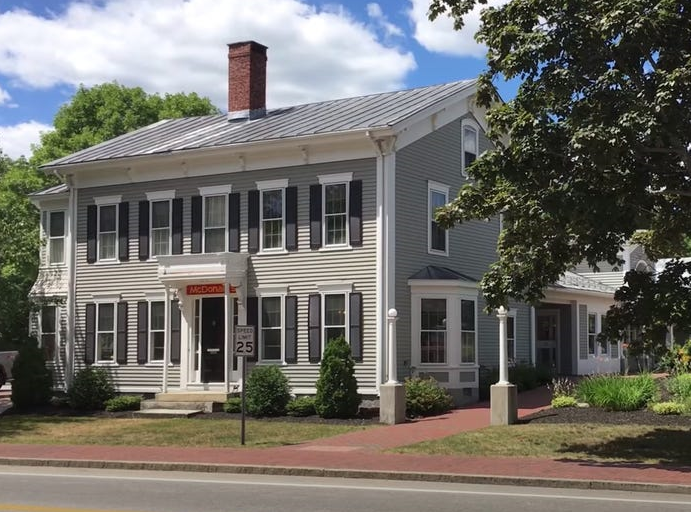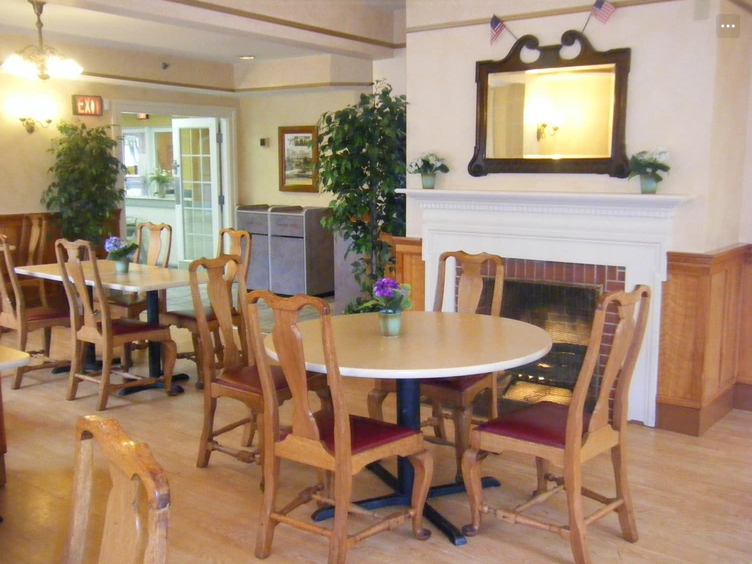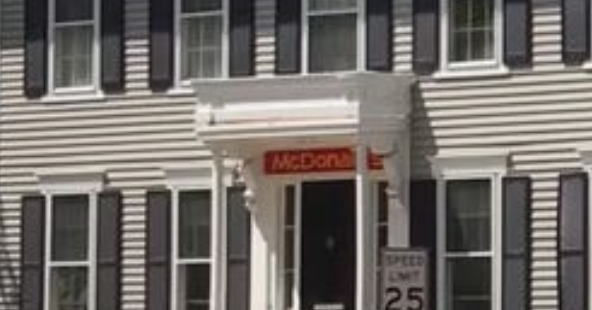Is This Upscale Fast Food?

The town of Freeport, Maine has been around since 1789. Today, it’s home to about 86,000 residents and the world headquarters for outdoor apparel company L.L Bean, but if you walk or drive through the town, you’ll see a lot of structures like the one above. Built in the mid-1800s, the building is one of many common in the area; in 2008, for example, Preservation Magazine described the building above as a “white Greek revival house on the corner [that] is just another historic mansion” among many in Freeport. And from the outside, it mostly is — and for that matter, from the inside, too, at least to a degree. Here’s a picture of the interior, via here, and it just looks like a regular casual or perhaps upscale-ish restaurant with its carved wood chairs and working fireplace.

But it’s not a fancy restaurant. It’s not even an Olive Garden. See that little red sign above the door in the top-most picture? Let’s zoom in.

Yep. The “white Greek revival house on the corner [that] is just another historic mansion” is also a McDonald’s.
If you’re familiar with McDonald’s — and you almost certainly are — they usually don’t look like old New England coastal mansions. The brand is known for its “golden arches” — a huge yellow M — usually against a red background. The buildings usually have the word “McDonald’s” in larger letters on them, not a small easily-missed sign under the awning above the front door. There’s often that yellow-on-red M logo adorning a sign on the side of the building and/or an oversized sign near the road, just to make it incredibly clear that the place you’re about to drive past is, in fact, a McDonald’s. Subtlty isn’t the goal; awareness is. And in any event, McDonald’s franchises almost never have wood siding and shutters on their facade.
The McDonald’s in Freeport is just different. Although that wasn’t the original plan.
The McDonald’s Corporation decided to move into Freeport for the first time in 1982, acquiring the building above. It was known llocally as the Gore House, after William Gore, the 1800s merchant who built the home, but really, no one in the area thought much of the building — it was yet another mansion on a street full of them. That is, no one really cared until McDonald’s bought it and sought permission to knock it down. Freeport’s town government — and it’s citizens — wouldn’t have it. As Food and Wine explains, “Freeport is one of those towns where almost every house looks like it was ripped out of Gilmore Girls. It’s beautiful and quiet and somehow still quaint despite the many outlet stores and parking lots. Back before McDonald’s moved in—when things were still up in the air—the town of Freeport labored to preserve the timeless look of the town via strict zoning laws, dutifully enforced by the Freeport Zoning Board of Appeals.”
Bulldozing a home from the 1850s to sell some Big Macs didn’t sit well with the locals, with some forming a group called “Mac Attacks,” intending to force McDonald’s out of town entirely. The zoning board reacted by adopting new restrictions on what could be done in town, making them even more restrictive than before, and many figured McDonald’s would just sell the building instead of making any further investment. But instead, the burger chain decided to submit a proposal that met the letter of the law. No gaudy red signage, no oversized golden arches, very few streetside decor changes, and certainly, no changes at all to the white paneling and black shutters. In December of 1983, Mickey D’s took their plan to the zoning board, and, as reported by the New York Times, the panel agreed.
Today, McDonald’s seems to have held onto its promise to keep the local architectural character pretty much in place. As Atlas Obscura notes, “one could walk in and think that this was just a local posh tavern, like the one across the street.” The menu, though, is very much what you’d expect at McDonald’s, not at a local restaurant — with one occasional exception. Business Insider reports that the Freeport McDonald’s “is known to serve lobster rolls in the summer,” but don’t plan a trip around that particular lunch: “the menu item isn’t always available every year.”
Bonus fact: Montpelier, the capital of the state of Vermont, is about a four-hour drive west of Freeport. Like Freeport, Montpelier was settled by Europeans in the 1700s and is now home to about 8,000 people. And like Freeport, Montpelier’s zoning laws aim to preserve the local architecture and are hostile to chain restaurants opening their doors there. But unlike Freeport, McDonald’s never tried to work around the Montpelier zoning laws, so there aren’t any McDonald’s in Montpelier. That makes the city unique; it’s the only U.S. state capital without a Mickey D’s. (As seen on this map, there is one right outside the city limits — in Barre, Vermont.)
From the Archives: McMansion: Another McDonald’s hidden in a fancy building.
